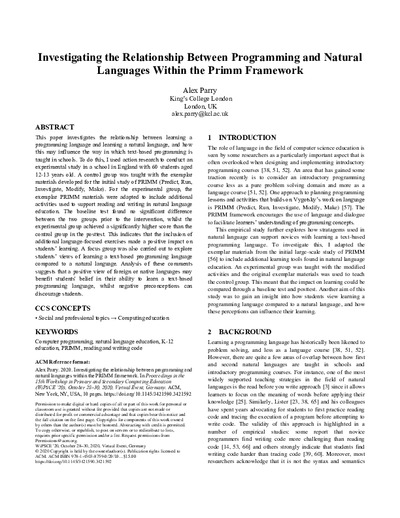Investigating the relationship between programming and natural languages within the primm frameworkAlex Parry
Publikationsdatum:
Zu finden in: WiPSCE '20, 2020
|
 |
 Diese Seite wurde seit 3 Jahren inhaltlich nicht mehr aktualisiert.
Unter Umständen ist sie nicht mehr aktuell.
Diese Seite wurde seit 3 Jahren inhaltlich nicht mehr aktualisiert.
Unter Umständen ist sie nicht mehr aktuell.
 Zusammenfassungen
Zusammenfassungen

This paper investigates the relationship between learning a programming language and learning a natural language, and how this may influence the way in which text-based programming is taught in schools. To do this, I used action research to conduct an experimental study in a school in England with 60 students aged 12-13 years old. A control group was taught with the exemplar materials developed for the initial study of PRIMM (Predict, Run, Investigate, Modify, Make). For the experimental group, the exemplar PRIMM materials were adapted to include additional activities used to support reading and writing in natural language education. The baseline test found no significant difference between the two groups prior to the intervention, whilst the experimental group achieved a significantly higher score than the control group in the posttest. This indicates that the inclusion of additional language-focused exercises made a positive impact on students' learning. A focus group was also carried out to explore students' views of learning a text-based programming language compared to a natural language. Analysis of these comments suggests that a positive view of foreign or native languages may benefit students' belief in their ability to learn a text-based programming language, whilst negative preconceptions can discourage students.
 Dieses Konferenz-Paper erwähnt ...
Dieses Konferenz-Paper erwähnt ...
 Personen KB IB clear | Angela Carbone , Quintin I. Cutts , Paul Denny , Sarah Esper , Marlena Fecho , Colin J. Fidge , Stephen R. Foster , Simon Gray , Richard James , Maria Kallia , Raymond Lister , Mike Lopez , Andrew Luxton-Reilly , Philip Machanick , Jerry Mead , Phil Robbins , Anthony Robins , Janet Rountree , Nathan Rountree , Jorma Sajaniemi , Sue Sentance , Judy Sheard , Beth Simon , Juha Sorva , Caroline St. Clair , Donna Teague , Errol Thompson , Vesa Vainio , Jane Waite , Jacqueline L. Whalley | ||||||||||||||||||||||||||||||||||||||||||||||||||||||||||||||||||||||||||||||||||||||||||||||||||||||||||||
 Begriffe KB IB clear | action researchaction research
,  Lernen Lernen learning
, notional machine
, learning
, notional machine
,  Programmieren Programmieren programming
, programming
,  Schule Schule school
, school
,  Sprache Sprache language
, Sprachenlernenlanguage learning language
, Sprachenlernenlanguage learning
| ||||||||||||||||||||||||||||||||||||||||||||||||||||||||||||||||||||||||||||||||||||||||||||||||||||||||||||
 Bücher |
| ||||||||||||||||||||||||||||||||||||||||||||||||||||||||||||||||||||||||||||||||||||||||||||||||||||||||||||
 Texte |
|
 Dieses Konferenz-Paper erwähnt vermutlich nicht ...
Dieses Konferenz-Paper erwähnt vermutlich nicht ... 
 Nicht erwähnte Begriffe | Bildung, Fremdsprache, Fremdsprachenlernen, Kinder, LehrerIn, Unterricht |
 Tagcloud
Tagcloud
 Zitationsgraph
Zitationsgraph
 Zitationsgraph (Beta-Test mit vis.js)
Zitationsgraph (Beta-Test mit vis.js)
 Zeitleiste
Zeitleiste
 Anderswo finden
Anderswo finden
 Volltext dieses Dokuments
Volltext dieses Dokuments
 |  Investigating the relationship between programming and natural languages within the primm framework: Fulltext at the ACM Digital Library ( Investigating the relationship between programming and natural languages within the primm framework: Fulltext at the ACM Digital Library ( : :  , 491 kByte; , 491 kByte;  : :  ) ) |
 Anderswo suchen
Anderswo suchen 
 Beat und dieses Konferenz-Paper
Beat und dieses Konferenz-Paper
Beat hat Dieses Konferenz-Paper während seiner Zeit am Institut für Medien und Schule (IMS) ins Biblionetz aufgenommen. Beat besitzt kein physisches, aber ein digitales Exemplar. Eine digitale Version ist auf dem Internet verfügbar (s.o.). Es gibt bisher nur wenige Objekte im Biblionetz, die dieses Werk zitieren.


















 Biblionetz-History
Biblionetz-History